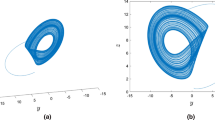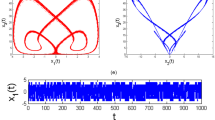Abstract
This paper comprehensively studies effective numerical methods for solving the simplest chaotic circuit model. We introduce a novel scheme for the Atangana–Baleanu Caputo fractional derivative (ABC-FD), coupled with the Laplace decomposition method (LDM). Furthermore, we rigorously compare the performance of these proposed methods with the Runge–Kutta fourth-order method. Using two mathematical techniques, we have discovered effective and highly convergent solutions to the chaotic model. We gave different values to the parameters to plot the chaos and create a phase portrait of the system. Therefore, the provided methods can be applied to more sophisticated examinations of different models. This study advances numerical techniques for understanding chaotic dynamics in complex systems. By introducing a novel scheme for the Atangana–Baleanu Caputo fractional derivative and the Laplace decomposition method, we provide a robust framework for effectively solving the simplest chaotic circuit model. This framework enhances accuracy and efficiency in unraveling chaotic behaviors, contributing to a broader understanding of chaotic dynamics across scientific domains in the future.



Similar content being viewed by others
Data availability
No data were used to support this study.
References
Podlubny I (1999) Fractional differential equations. Academic Press, New York
Oldham KB, Spanier J (1974) The fractional calculus. Academic Press, New York
Gorenflo R, Mainardi F (1997) Fractional calculus. In: Carpinteri A, Mainardi F (eds) Fractals and fractional calculus in continuum mechanics, vol 378. International Centre for Mechanical Sciences. Springer, Vienna
Samko G, Kilbas A, Marichev O (1993) fractional integrals and derivatives: theory and applications. Gordon and Breach, Amsterdam
Dudkowski D, Jafari S, Kapitaniak T, Kuznetsov NV, Leonov GA, Prasad A (2016) Hidden attractors in dynamical systems. Phys Rep 637:1–50
Xu G, Shekofteh Y, Akgül A, Li C, Panahi S (2018) A new chaotic system with a self-excited attractor: entropy measurement, signal encryption, and parameter estimation. Entropy 20(2):86
Lai Q, Akgul A, Li C, Xu G, Çavuşoğlu Ü (2017) A new chaotic system with multiple attractors: dynamic analysis, circuit realization and S-Box design. Entropy 20(1):12
Petráš I (2008) A note on the fractional-order Chua’s system. Chaos Solitons Fractals 38(1):140–147
Abd El-Maksoud AJ, Abd El-Kader AA, Hassan BG, Rihan NG, Tolba MF, Said LA, Radwan AG, Abu-Elyazeed MF (2019) fpga implementation of sound encryption system based on fractional-order chaotic systems. Microelectronics 90:323–35
Kumar S, Kumar R, Cattani C, Samet B (2020) Chaotic behaviour of fractional predator–prey dynamical system. Chaos Solitons Fractals 135(109811):109811
Toufik M, Atangana A (2017) New numerical approximation of fractional derivative with non-local and non-singular kernel: application to chaotic models. Eur Phys J Plus 132(10):444
Abdoon MA, Saadeh R, Berir M, El Guma F, Ali M (2023) Analysis, modeling and simulation of a fractional-order influenza model. Alexandr Eng J 74:231–40
Li P, Han L, Xu C, Peng X, ur Rahman M, Shi S (2023) Dynamical properties of a meminductor chaotic system with fractal–fractional power law operator. Chaos Solitons Fractals 175:114040
ur Rahman M, El-Shorbagy MA, Alrabaiah H, Baleanu D, la sen MD (2023) Investigating a new conservative 4-dimensional chaotic system. Results Phys 53:106969
Du S, Haq NU, Rahman MU (2023) Novel multiple solitons, their bifurcations and high order breathers for the novel extended Vakhnenko–Parkes equation. Results Phys 54:107038
ur Rahman M (2022) Generalized fractal–fractional order problems under non-singular Mittag–Leffler kernel. Results Phys 35:105346
Qu H, ur Rahman M, Ahmad S, Riaz MB, Ibrahim M, Saeed T (2022) Investigation of fractional order bacteria dependent disease with the effects of different contact rates. Chaos Solitons Fractals 159:112169
Alzahrani ABM, Abdoon MA, Elbadri M, Berir M, Elgezouli DE (2023) A Comparative numerical study of the symmetry chaotic jerk system with a hyperbolic sine function via two different methods. Symmetry 15(11):1991
Ghanbari B, Atangana A (2020) Some new edge detecting techniques based on fractional derivatives with nonlocal and non-singular kernels. Adv Differ Equ 2020(1):1–19
Sene N (2020) Second-grade fluid model with Caputo–Liouville generalized fractional derivative. Chaos Solitons Fractals 133(109631):109631
Petras I (2002) Control of fractional-order Chua’s system. J Electron Eng 53(8):219–222
Elbadri M (2022) Initial value problems with generalized fractional derivatives and their solutions via generalized Laplace decomposition method. Adv Math Phys 2022:1–7
Elbadri M, Ahmed SA, Abdalla YT, Hdidi W (2020) A new solution of time-fractional coupled KdV equation by using natural decomposition method. Abstr Appl Anal 2020:1–9
Saadeh R, Ghazal B, Burqan A (2023) A study of double general transform for solving fractional partial differential equations. Math Methods Appl Sci 46(16):17158–17176
Matouk AE (2023) Chaotic attractors that exist only in fractional-order case. J Adv Res 45:183–192
Hasan FL, Abdoon MA (2021) The generalized (2 + 1) and (3+1)-dimensional with advanced analytical wave solutions via computational applications. Int J Nonlinear Anal Appl 2021(2):1213–1241
Hosseini K, Mayeli P, Ansari R (2018) Bright and singular soliton solutions of the conformable time-fractional Klein–Gordon equations with different nonlinearities. Waves Random Complex Media 28(3):426–434
Abdoon MA, Hasan FL (2022) Advantages of the differential equations for solving problems in mathematical physics with symbolic computation. Math Model Eng Probl 09(01):268–276
Qazza A, Saadeh R (2023) On the analytical solution of fractional SIR epidemic model. Appl Comput Intell Soft Comput 2023:1–16
Elbadri M, Abdoon MA, Berir M, Almutairi DK (2023) A numerical solution and comparative study of the symmetric rossler attractor with the generalized Caputo fractional derivative via two different methods. Mathematics 11(13):2997
Kumar S, Ahmadian A, Kumar R, Kumar D, Singh J, Baleanu D, Salimi M (2020) An efficient numerical method for fractional SIR epidemic model of infectious disease by using Bernstein wavelets. Mathematics 8(4):558
Taghvaei A, Georgiou TT, Norton L, Tannenbaum A (2020) Fractional SIR epidemiological models. Sci Rep 10(1):20882
Losada J, Nieto JJ (2015) Properties of a new fractional derivative without singular kernel. Progr Fract Differ Appl 1(2):558
Chua LO, Kang SM (1976) Memristive devices and systems. Proc IEEE Inst Electr Electron Eng 64(2):209–23
Muthuswamy B, Chua LO (2010) Simplest chaotic circuit. Int J Bifurcat Chaos Appl Sci Eng 20(05):1567–1580
Sah MP, Yang C, Kim H, Muthuswamy B, Jevtic J, Chua L (2015) A generic model of memristors with parasitic components. IEEE Trans Circuits Syst I 62(3):891–898
Hu H, Cao Y, Xu J, Ma C, Yan H (2021) An image compression and encryption algorithm based on the fractional-order simplest chaotic circuit. IEEE Access 9:22141–22155
Ruan J, Sun K, Mou J, He S, Zhang L (2018) Fractional-order simplest memristor-based chaotic circuit with new derivative. Eur Phys J Plus 133(1):3
Teng L, Iu HHC, Wang X, Wang X (2014) Chaotic behavior in fractional-order memristor-based simplest chaotic circuit using fourth degree polynomial. Nonlinear Dyn 77(1–2):231–241
Jafari H, Khalique C, Nazari M (2011) Application of the Laplace decomposition method for solving linear and nonlinear fractional diffusion-wave equations. Appl Math Lett 24:1799–1805
Wazwaz AM (2010) Partial differential equations and solitary waves theory. Springer, Berlin
Toufik M, Atangana A (2017) New numerical approximation of fractional derivative with non-local and non-singular kernel: application to chaotic models. Eur Phys J Plus 132:444
Bhalekar S, Daftardar-Geji V (2012) Solving a system of nonlinear functional equations using revised new iterative method. Int J Math Comput Phys Electron Comput Eng 6:8–21
Qazza A, Abdoon M, Saadeh R, Berir M (2023) A new scheme for solving a fractional differential equation and a chaotic system. Eur J Pure Appl Math 2023(2):1128–1139
Saadeh R, Abdoon M, Qazza A, Berir M (2023) A numerical solution of generalized Caputo fractional initial value problems. Fractal Fract 7(4):332
Elbadri M, Abdoon MA, Berir M, Almutairi DK (2023) A symmetry chaotic model with fractional derivative order via two different methods. Symmetry 15(6):1151
Qazza A, Saadeh R, Alayed O, El-Ajou A (2023) Effective transform-expansions algorithm for solving non-linear fractional multi-pantograph system. AIMS Math 8(9):19950–19970
Acknowledgements
The authors would like to extend their sincere appreciation to the Researchers Supporting Project number (RSPD2023R920), King Saud University, Saudi Arabia.
Funding
The Researchers Supporting Project Number (RSPD2023R920), King Saud University, Saudi Arabia.
Author information
Authors and Affiliations
Contributions
Author Contributions: Conceptualization: RS, MA, ME and AQ, methodology: AA, RS, MB and AQ, software: AA, RS, MB and AQ, formal analysis: RS, MA, MB and AQ, investigation: MA, ME, MB & AQ, resources: AA, RS, ME, MB, data curation AA, ME, MB and AQ, writing—original draft preparation: AA, RS and AQ, writing—review and editing: AA, RS, MA, ME, MB, and AQ. All authors reviewed the manuscript.
Corresponding author
Ethics declarations
Conflict of interest
The authors declare no conflict of interest.
Additional information
Publisher's Note
Springer Nature remains neutral with regard to jurisdictional claims in published maps and institutional affiliations.
Rights and permissions
Springer Nature or its licensor (e.g. a society or other partner) holds exclusive rights to this article under a publishing agreement with the author(s) or other rightsholder(s); author self-archiving of the accepted manuscript version of this article is solely governed by the terms of such publishing agreement and applicable law.
About this article
Cite this article
Alzahrani, A.B.M., Saadeh, R., Abdoon, M.A. et al. Effective methods for numerical analysis of the simplest chaotic circuit model with Atangana–Baleanu Caputo fractional derivative. J Eng Math 144, 9 (2024). https://doi.org/10.1007/s10665-023-10319-x
Received:
Accepted:
Published:
DOI: https://doi.org/10.1007/s10665-023-10319-x




